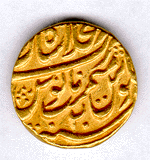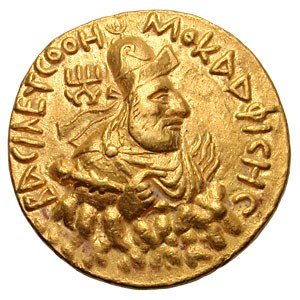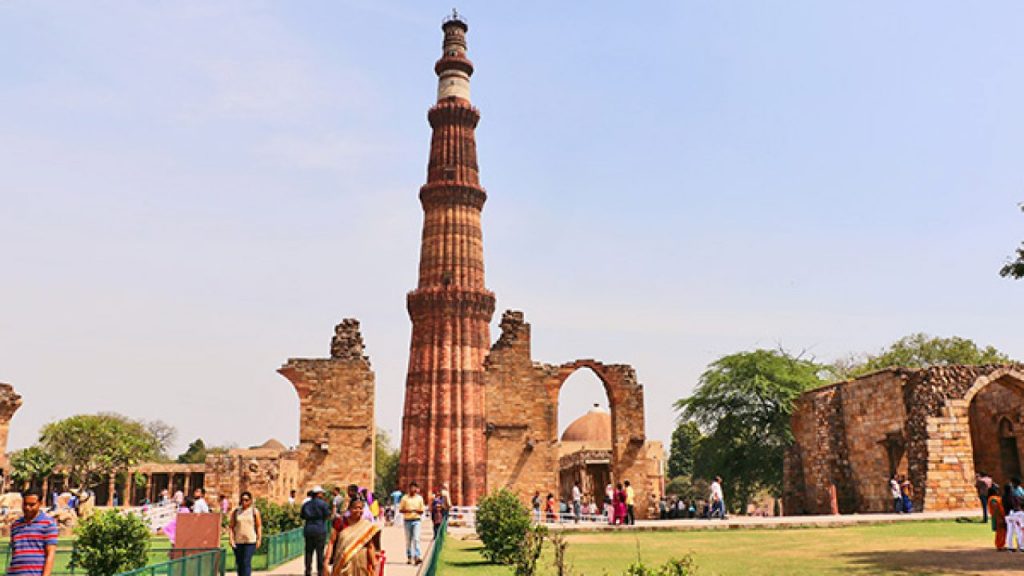
By end of the 8th century AD, a new chapter had began in the Indian history, it was an arrival of Islam. By this time, many Arab tribes were united and had conquered Iran (Persia). The wealthy cities of northern and central India and rich ports of western coast were great temptations. The repeated attacks on the Hindu Shahi of Kabul, the proud descendants of Kushan ruler, Kanishka, was the first successful step. This Brahmanical Shahi of modern Afghanistan & Pakistan, whose rulers patronized various schools of Buddhist and Hindu arts and popularized `Bull & Horseman’ type of coins (shown in `Western & Central Indian dynasties’ section), put up a brave struggle, but eventually perished by the 8th century AD. Arabs conquered Afghanistan, Baluchistan and later seized Sindh region (located in modern Pakistan), which became the first Islamic territory in the Indian subcontinent.
During this period, a good deal of cultural exchange took place. Arabs acquired from the Indians the knowledge in concepts of philosophy, medicine, mathematics (numbers as well as the concept of zero, today commonly known as Arabic numerals/numbers), astronomy and folklore, which they carried to Persia (Iran) and Arabia and eventually to Europe, when they conquered Spain.
It was in 10th century AD, the second invasion of India took place, carried by Mahmud of Ghazni (a city in Afghanistan, also known as Ghazna). Mahmud invaded India 17 times, mainly for the acquisition of `wealth of Hindustan’. He took control of of Punjab and later sacked rich city capitals of many post-Gupta dynasties, including Kanyakubj (modern Kannauj). His expedition against celebrated shrine of Somnath, located in modern Gujrat is reported in contemporary writings and provide detail description of desecration of the main idol and the massive war booty. Mahmud’s all the expeditions were mere annual raids undertaken mainly with the object of plunder, destroying temples, desecration of idols and sculptures. He put no efforts to rule the newly acquired domains.
Madmud minted interesting coins which are atypical and provides a considerable historical information. His silver coins are special in Indian numismatics as they have his name written on coins in two different languages. On obverse legends are in Arabic, but on reverse the legends are in Sanskrit, written in Devanagri script! The legend on reverse reads Avyaktamekam Muhammad Avatar Nrupati Mahmud in center and around it, the legends reads Avyaktiya Name Ayam Tankam Hato Mahmudpur Sanvanto 418. Obviously, the local population did not know Arabic, a foreign language and this fact made him issue these bilingual coins, a phenomenon not new to North-Western India. Earlier Indo-Greeks and Kushan also minted bilingual coins, where on obverse legends were in Greek, while on reverse they were engraved in local Kharoshti script. Well, history does repeat itself!
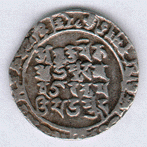
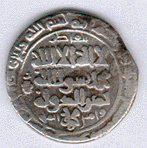
Mahmud of Gazni
998-1030 (388-421 AH)
Obverse: Arabic Legends
Reverse: Sanskrit legends; Minted at Mahmudpur (Lahore)
Reference: MI#773a
Rare
Silver Dirham, Weight: 3.0 gm
Coins of Early Islamic Dynasties
The empire of Gazni was shattered after death of Mahmud of Gazni and after major political struggle and confusion, Muhammad Ghori (or Ghur or Ghor) took control of Gazni. Soon Ghori invaded India. Delhi was then under control of brave king of Chahamana dynasty Prithviraja III (popularly known as Prithviraj Chauhan or Rai Pithora). Ghori had to face a massive cavalry of 200,000 and 1000 war elephants under command of Prithviraja and his fellow friendly kings. Prithviraja won a great victory and Ghori had to flee to save his life (for coins of Chauhan/Chahamana dynasty of Ajmer and Delhi visit `Western & Central Indian Coinage’ section of this webpage). But Ghori soon came back and this time he was better prepared. Unfortunately, Prithviraj had not taken the second invasion of Ghori seriously. He hardly paid attention towards getting help of other princes. Jaichandra Gahadavala (Jaichand), who ruled from Banaras was considered to be the another powerful king of India. There was bitter rivalry between Chahamana and Gahadaval dynasties, the two most prominent dynasties of northern India. According to legend Jaichand’s daughter preferred to marry Prithviraj against her father’s wishes, which made Jaichandra to remain in Banaras, instead of taking a joint stand against Ghori. In historically crucial “second battle of Terain”, Ghori defeated overconfident Prithviraja. Prithviraja was captured alive, he was blinded and finally put to death. The second battle of Terain (near Panipat) laid the foundation of Muslim dominion in northern India.
`

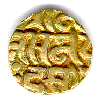
Muhammad bin sam Ghori
1173-1206 ADGold Stater
Weight: 4.2 gm
Obverse: Laxmi sitting
Reverse: Legends in Devanagri script, minted at Delhi
Reference: MNW#512
During his stay at Delhi, Ghori minted both silver and gold coins. His silver coins were almost identical to Prithviraja’s coins. The obverse showed Bull while the reverse had horseman with the legends which which read Muhamamad bin sam instead of Prithvi Deva. Shown above is the gold coin of Ghori depicting four armed Laxmi on obverse, which is highly stylized version from Gupta dynasty and later medieval North-central dynasties. On reverse, the legends are in Devanagri script, which reads Srimad Hamir Mahamad Sam. This is a rare example where a Muslim King issued the coin depicting Hindu deity, possibly of widespread acceptance of Laxmi or Lakshmi depicting coins by majority of population and merchants during the post-Gupta era.
Coins of Slave Dynasty of Delhi
Like his predecessor Mahmud of Ghazni, Ghori too hardly paid any attention in ruling the region that he conquered. He just indulged himself in collecting the largest possible plunder and in that process carried out massacre of defeated soldiers & mass enslaving women/children. He could not enjoy his newly acquired wealth, he was murdered in his camp in cold blood while on the way back home to Afghanistan, probably by the group of people whose families were massacred.
Ghori had no son and this was an opportunity which made his Turkish general, Qutb-ud-din Aibak to take over this sultanate of Delhi. Qutub thus established the first Islamic dynasty of India. This dynasty is popularly called as Slave dynasty since Qutub had been a slave of Ghori and later became his most trusted General. He was the major force in incorporating all the neighboring kingdoms viz. Banaras and Kanauj, Hansi, Merath, Ranthambor, and Bundelkhand into the first Islamic empire of India.
He died leaving no male heir and which resulted in another power struggle resulting in a favor of Iltutmish, another Turkish Slave. Like his master Qutub, Iltutmish too began as a slave but because of his merits, was manumitted and later even managed to marry his master’s daughter! Iltutmish faced a lot of rebellions but he swiftly acted and effectively suppressed all of them, keeping him in complete control of his sultanate. He later even received a robe of honor from Khalifa of Baghdad confirming as a Sultan-i-Azam, the great sultan. On his coins he describe himself as lieutenant of the Khalifa. He died in 1236 AD after reigning for 26 years. Iltutmish can be considered as the best of all the Turkish sultans, who ruled from Delhi. He consolidated the sultanate in India and also took up considerable building activity. He completed the famous Qutub Minar, a minarate near Delhi (named after a Sufi saint, NOT after his father-in-law), the tallest among all the pre-modern structures and nearby Quwwat-Ul-Islam Mosque (considered to be the first mosque of India) at Delhi, which was started by his master and father-in-law Qutub-ud-din-Aibak.
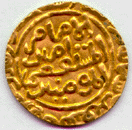

Balban
1266-1287 AD (664-686 AH)
Gold Tanka
Weight 11.1 gms
Minted at Delhi
Reference: R#942
Iltutmish did something which happened only once in entire Islamic history of India. On his deathbed he nominated his daughter Raziyya (Raddiya in Arabic) to succeed him as heiress to throne. The brothers of Raziyya were utter hopeless and she was left on her own to rule large part of India. She was not the welcome ruler and practically all her nobles hated the fact that they were bowing before a woman! Raziyya may (or may not) have showed consideration towards an Abyssanian (person of eastern African descent) slave Yakub, who was a master of royal stable. However, her Turkish and Afghan nobles used this information (likely to be false) and seized the opportunity to rebel against her. The first revolt was by Altuniya, the governor of Sarhind. Queen marched with large army to suppress the revolt, but her own nobles imprisoned her during the conflict and slew Yakut. She promptly married Altuniya and marched back to Delhi to claim throne from the new Sultan, her brother Muiz-ud-din Bahram. Just before the battle, she was deserted by the officers of Altuniya, her new husband and she was defeated. She was caught alive and put to death along with her husband next day, 20th October 1240 AD.
Death of Raziyya created utter confusion and disorder in Delhi. She was followed by three of her brothers, none proved to be competent to rule. Mongols took this opportunity and entered Punjab and captured Lahore. At this time, Ghiyas-ud-din Balban, a minister of youngest of Raziyya’s brother took control. He repelled Mongols from Punjab and on death of Sultan, he ascended the throne of Delhi.
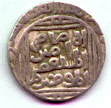
Balban
1266-1287AD (664-686 AH)
Silver Tanka
Weight: 11 gm
Minted at Hazrat Delhi
Reference: MWI#2516
Like earlier two sultans Qutub and Iltutmish, Balban too was a Turkish slave (not again!). He was bought by Iltutmish and by his ability he rose to become minister and later king. Entire 22 years of his reign was spent in suppressing rebellions of his governors (Bengal took a lot of his energy) and confronting Mongols in north-west frontier. While fighting against Mongols, his able and favorite son was killed, which broke 80 years old sultan’s heart. He died in 1287 AD leaving his empire for next round of bloodshed in determining the ultimate ruler. Shown above is a fine coin of silver, called Tanka, issued by Balban.
Balban was followed by his 18 year old grandson Kaikubad, who paid no attention to affairs of state and plunged himself in whirlpool of pleasure. His nobles got divided into two groups, Turkish group and Afghan group. The Afghan group lead by Jalal-ud-din Firuz Shah Khilji acted swiftly. Afghan nobles killed Turkish nobles and later murdered young sultan and his infant son. And thus the slave dynasty (1206-1290 AD) ruled by Turks of Ilbari tribe (not Pathans, as many people think) for almost a century came to an ignominious end.
The Slave dynasty introduced new reforms in Indian monetary system, which lasted for centuries. A coin of about 11.6 gm in gold and silver was issued, popularly called Tanka. The weight represents the Indian measure of precious metal Tola. The later silver and Gold coinage minted by Mughals (Mohur and Rupee) were also based on this weight standards.
Coins of Khilji
Firuz Shah was a old man of seventy when he ascended to throne of Delhi. He was person of mild and tender disposition, but still managed to win a decisive victory over Mongol army of 150,000 led by grandson of Halaku (Halagu). He brought up his fatherless nephew, Ala-ud-din Khilji, with a lot of affection and later made him son-in-law by marrying his favorite daughter to him. He made Ala-ud-din in charge of Kara near Allahabad and later Awadh or Oudh.
Ala-ud-din grew more ambitious. A kingdom of Devgiri, which was fabulously wealthy kingdom of Deccan or Dakkhan (modern Maharashtra state) was his first target. Without taking permission from the Sultan. He made a surprise attack with just few hundred of a cavalry and defeated the Yadava (Jadhav) king of Devgiri, Ramchandradeva. Ramchandradeva tried to take help from other southern Hindu kings, but no help arrived in time and he had to sue for peace. Ala-ud-din extracted massive booty in gold, silver, silks, pearls and precious stones.
This raid of Devgiri (later named as Daulatabad) widened his ambitions and that led to design a trap to kill his uncle, the sultan Firuz Shah. Unfortunate Firuz Shah blinded by his fondness to his son-in-law and nephew walked into the trap and was murdered in cold blood. Ala-ud-din lavishly distributed his Devgiri war booty among nobles and people of Delhi, which paved way for him to become next Sultan of Delhi. He soon strengthened his position by killing all the contenders (his cousins and nephews) and later slaughtering 30,000 Mongols living near Delhi in one single day! Mongols lost the spirit and did not invade India for very long time. Alaudding married Devagiri Princess, Jhatyapalli, and her son was the next ruler, Shihabuddin Omar.


Ala-ud-din Khilji
1296-1316 AD
Gold Tanka
Weight: 11 gms
Minted at Devgiri
Reference: R#999
The initial success in many close fought battles turned his head and he began talking about establishing a `new religion’ and started dreaming himself to be `the second Alexander’, after the Macedonian King, Alexander III. He even minted the gold coins proclaiming himself to be the second Alexander (Sikandar al Sani), an example of such coin is shown above. He began expansion of his empire by incorporating the remaining independent kingdoms. First he sent his army to prosperous kingdom of Gujrat, then ruled by Rai Karnadeva II, a Baghela (Vaghela) Rajput prince. Karnadeva lost the battle and managed to escape with his daughter Devala Devi to Devagiri, but his queen Kamala Devi was captured. Army returned to Delhi with enormous booty in gold, silver and precious stones with queen and a young eunuch, Malik Kafur. Ala-ud-din married Kamala Devi, who later became his favorite queen, while Kafur rose to become most powerful noble and eventual master of the empire.
India witnessed a massive empire under Khiljis and Tughluqs, which incorporated region from Afghanistan to modern Karnataka state. But it collapsed; the strength of the ruler at Delhi was always the criterion for the empire size. Whenever the weaker ruler on the throne, the governors and other generals at far off places declared their independence and created own kingdom. Soon, there were half a dozen of large kingdoms all over the India, popularly called Sultanates. Jaunpur, Bengal, Gujrath, Bahamani are some of these sultanates that sprung all over India upon demise of Delhi sultanate.
Coins of Mughal
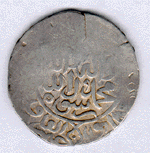
Babur, a Chagatai Turk, was descendent of Timur-Lang and Chingiz Khan, the Mongol warriors. Lodi dynasty had followed Khiljis at Delhi and Ibrahim Lodhi was the ruler. Babur when arrived, he was suitably impressed; the Lodhi army was massive, war elephants being the first line of defense, against which significantly smaller Babur’s army was no match. However, he had a new weapon, used first time in Indian subcontinent, gun powder/canon. Elephants were targeted specifically, and their scattering brought the total chaos. Battle-hardened army of Babur, made of mongol, central Asian and Afghan horsemen was quick to cash on, the battle was decisively won. Thus, Babar founded the Mughal empire by defeating Ibrahim Lodhi at the first battle of Panipat in 1526 AD. The Mongol descendancy eventually fetched the name `Mughal’ for his newly founded empire in northern India (the word Mughal is Indian derivative of Mongol). He later won another decisive battle with Rana Sanga, a hero of Rajput warriors. Rajputs fought with desperate valor but lost in battle of Kanwa, near Agra in 1527. But Babur could not enjoy the fruits of his hard won victories, he died in 1530 leaving his unorganized empire to his son Humayun.
Coins minted by Babur lack beauty and elegance displayed by his successors, Akbar and Jahangir. Often the dies used to strike these coins were so worn or used improperly that only part of legends were visible on his coinage. Shown above is a fine 🙂 specimen of Babar’s coinage which is a rarity.
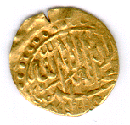
Humayun
1530-1556
ADGold Quarter Ashrafi
Minted at Badakhshan
Weight: 1.0 gm
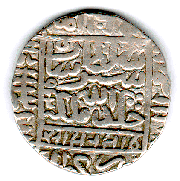
Sher Shah Suri
1539-1545 AD
Silver Rupee
Weight: 11.4 gm
Minted in 1545 AD at Gwalior
Reference: R#1659
As a king Humayun had a major early failure. Humayun could not retain control over his Sultanate and soon lost to Sher Shah Suri, an Afgan leader born in India in very humble family. Sher who had rendered a valuable service to Babur in his military campaign, rapidly rose in ranks and eventually became a ruler of Bihar. He soon defeated Humayun at Chaunsa near Buxar in 1539 and took control of Delhi and whole of Gangetic plains till Bengal. He died in 1545 in an accident caused by explosion of gunpowder. Sher was an architect of an administrative system, where he revived the traditional features of old administrative system of pre-Islamic period. He built the Grand trunk road (which still survives) from Sonargaon in modern Bangladesh to Indus in modern Pakistan. He showed religious tolerance thus helping him to strengthen his empire. The currency, `Rupee or Rupaya’ became popular during the reign of Sher, which is still in use in many countries including India, Nepal, SriLanka, Pakistan and Indonesia. The word Rupee is derived from Sanskrit word Roop, which means Silver. A fine example of this first Rupee, a silver coin of 11.4 gm, is shown above.
After the defeat, Humayun kept wandering in desert of India for next 15 years during which his son Akbar was born. At last with the help of Shah of Iran (Persia), he captured Kandahar and later took the opportunity to conquer India, as after death of Sher Shah, Delhi was in utter confusion. Like his father, he also could not live long to enjoy his newly acquired empire and died by an accidental fall from the staircase of his library in Delhi. Shown above is his gold coin.
AKBAR (1556-1605 AD)
His young son Akbar took control and had to face a major challenge from Hemchandra Vikramaditya (Hemu), a general of Afghan rulers of Bihar. Although not of royal lineage, Hemu was very capable general and had won 22 successive battles, when he marched towards Delhi. While Akbar was in Punjab, he captured Delhi, established his capital at Purana Quila (old fort) and proclaimed himself the ruler of India with a coveted title of Vikramaditya. The issue of supremacy had to be resolved, so both the armies met on battleground of Panipat. This was historically crucial battle, also known as the second battle of Panipat. The luck favored Akbar, as just when Mughals were losing the ground, a chance arrow struck King Hemu in the eye and he fell unconscious, creating confusion among his soldiers in battleground. Soldiers assumed that King Hemu is dead, and they deserted in mass. During this confusion, helpless Hemu was captured alive, slain immediately by Akbar. Mughals took advantage, and reoccupied Delhi and most of the territories of Afghan rulers and nobles. This ended the long Mughal-Afghan contest for supremacy in India, giving clear verdict in favor of the greatest Mughal, Akbar.
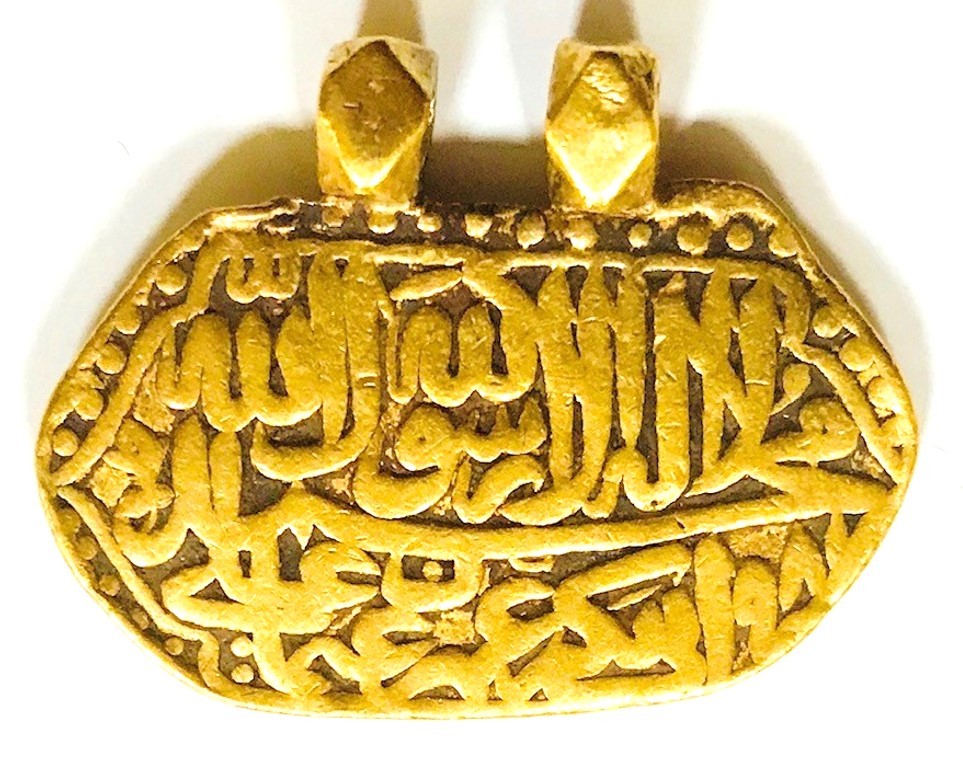
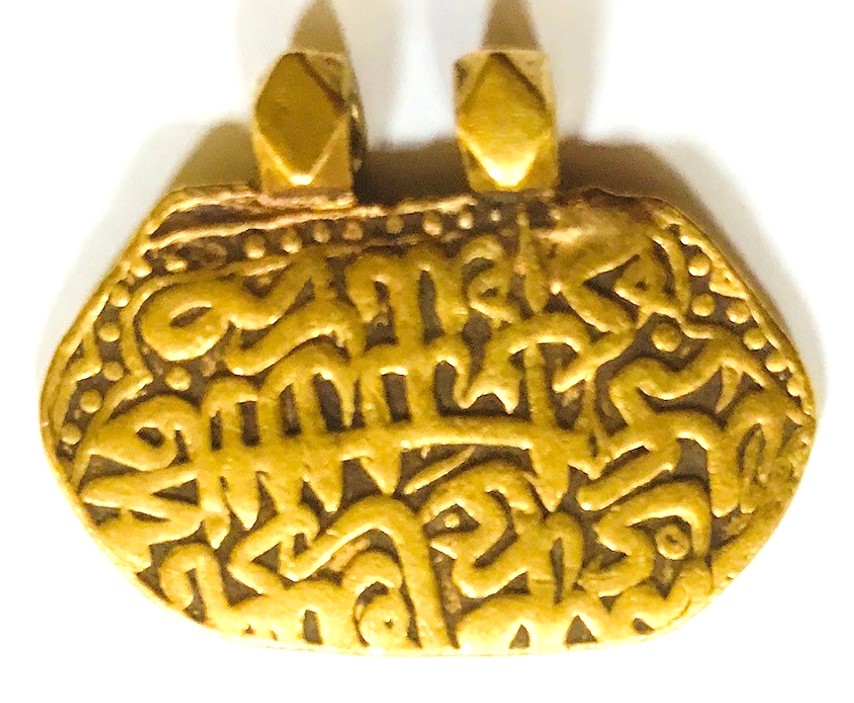
Akbar
Mughal Dynasty 1556-1605 AD or 963-1014 AH
Mehrabi Mohur, First year type
Weight: 12.07 gm with mount, Gold
Obverse: Inside Lozenge the Kalima, the legend `981 Abu Bakr Umar Usman Ali’
Reverse: Legend `Khalad mulkahu/ Badshah Gajhi/ Muhammad/ Jalaluddin Akbar/ Zarb baldat Agra’
Minted at Baldat Agra in 981 AH
Reference: BMC#50; KM#107.1; IMC#142; Carter 7; Wright 70 Hull 1204;Choice
Very Fine, two contemporary loops attached
Exceedingly Rare
Akbar issued many interesting coins. One of his most important coin display Lord Rama, the hero of Hindu Epic Ramayana and his wife Sita on obverse, while a word Ramaraj, in Devnagri script on reverse. This must have been a Nazarana gold Mohur minted for presentation to Hindu general or aristocrat. This coin (actually, a half Mohur) is in Paris museum.
He also issued an unique coin in Indian numismatic history, the Mehrabi Mohur, shown above. This exceedingly rare hexagonal gold coin minted in Agra in 981 AH had the Kalima on obverse with the legend `981 Abu Bakr Umar Usman Ali’. The Reverse Legend reads`Khalad mulkahu/ Badshah Gajhi/ Muhammad/ Jalaluddin Akbar/ Zarb baldat Agra’. These coins were made in the shape of Mihrab, a niche in the wall of mosque that indicates qibla (the direction towards Kaaba). The Mihrab mohurs were struck twice, this is the very first of the Mihrabi Mohur that depicts names of four Caliphs or Khalips, Abu-Bakr, Umar, Usman & Ali, and date in Ilahi era 981 AH ( 1573/74 AD), on obverse. These exceptional coins were minted the year Agra fort was built (where Akbar’s capital located) and might have been issued on that occasion. They were never in circulation and mostly hoarded by nobles, who used them as religious medallions, which explains the contemporary loops attached to this Mohur.
Shown below is another fine example of his silver coinage, a silver rupee which is square shaped.
Akbar tried to conciliate the brave Rajputs (the warrior clan of north-western India, well known for their fighting spirit) and secured their active co-operation in almost all his activities. His empire was in fact outcome of co-ordination of Mughal diplomacy and Rajput valor and service. Bihari Mall and his grandson Mann Singh of Amber (Jaipur) were the first Rajputs kings who cemented their friendship by matrimonial alliance. Many other Rajput rulers followed the suit including Bikaner and Jaisalmer and gave their daughters in the marriages to Akbar. The Rajput princess of Bikaner, Rajkumari Hira Kunwar (not Jodhabai, as most people think), borne him his legitimate son, Salim, who later inherited the empire and ruled India in the name of Jahangir.
The Mughal nobility came to comprise mainly the Central Asians (Turanis), Iranians (Iranis), Afghans, Indian Muslims of diverse subgroups, and Rajputs. Both historical circumstances and a planned imperial policy (cleverly devised by Akbar) contributed to the integration of this complex and heterogeneous ruling class into a single imperial service. Akbar saw to it that no single ethnic or religious group was large enough to challenge his supreme authority. This was a masterstroke of his military organizational ability, which secured the Mughal supremacy for centuries.
Akbar was perhaps the only secular Islamic ruler of India. Both, Akbar and to some degree his son Jahangir, displayed distinct secular behavior throughout their reigns. Akbar directed the translation of great Hindu Epics, Ramayana and Mahabharata, in Arabic/Persian and encouraged religious conferences involving different scholars. He lifted the religious tax `Jizia’ which all non-muslim population was forced to pay. Akbar even started a new religion, `Din-e-Elahi’ (a fact which have a death penalty according to Islamic scriptures). His liberal outlook helped him to attract a large number of intellectuals in his court irrespective of their beliefs. And, these politically wise decisions made people to accept Mughals as the rulers and helping Akbar and his successors strengthen the empire, which prospered and lasted for two more centuries.
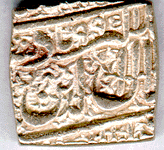
Akbar
1556-1605 AD
Silver Rupee, Square type
Minted at Surat (?)
Weight: 11 gms
JAHANGIR (1605-1627 AD)
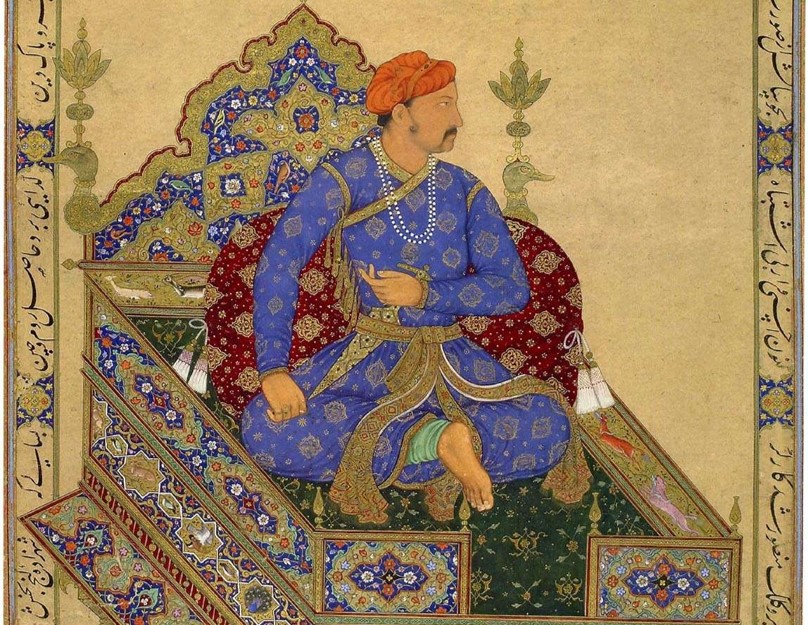
In Akbar’s old age Salim (named after a sufi saint whose blessings gave Hira Kunwar-Akabr their only son) rebelled against him and proclaimed himself an independent king at Allahabad. He even issued coins in his name as rebellious prince. Akbar died in 1605 and Salim took over the throne as Jahangir. Jahangir followed his father’s policies and favored large number of Rajput generals (his uncles and cousins) and scholars in his court. Jahangir married a Persian woman Mehrunissa, who soon became his favorite. She was given the title of NurJahan (the vision or eye of the world). By 1611 AD, Nurjahan along with her father, I’timad-ud-Dawlah, her brother Asaf Khan and Prince Khurram (later Shah Jahan), took control of Mughal empire and dominated politics until 1622. Thereafter, Jahangir’s declining years were darkened by a breach between Nur Jahan and Prince Khurram, who rebelled openly against him. In spite of all the attempts, nobody could succeed in replacing him and he ruled peacefully (relatively) till his death. Although, likely to be a heavy drinker and opium eater (which he overcame in his later day), Jahangir possessed sensitivity to nature, acute perception of human character, and artistic sensibility, which expressed itself in an unmatched patronage of painting. The Indian painting was at it’s apogee during Jahangir’s reign. He did not patronize the conservative Islamic elements and like his father, gave his subject liberty of expression of their religious faiths.
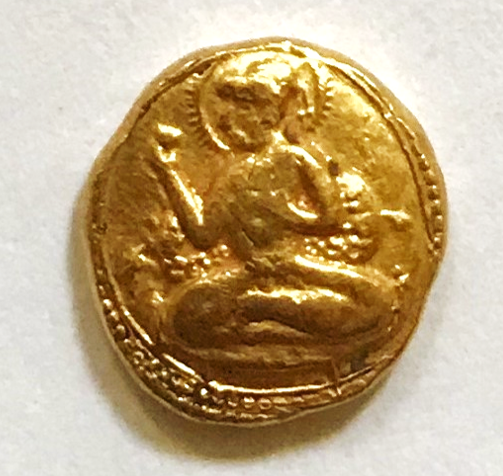
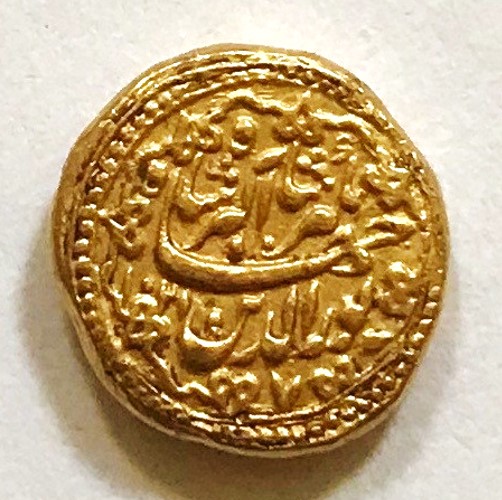
Jahangir
1605-1628 AD or 1014-1037 AH
Quarter Portrait Mohur, Weight: 2.84 gm, Gold
Obverse: Seated cross legged figure of Jahangir with radiate head to left on Mughal throne, holding goblet in right hand, within inner dotted circle
Reverse: The Persian legend `Akbar Shah Jahangir Shah Nuruddin’ and year below.
Minted in 1021 AH, Regnal year 7. No name of mint.
Reference: BMC#317; R.B. Whitehead, numismatic chronicle 1929, type VI, pp 21, plate 1, no 7; KM#172.1; IMC#153, Choice specimen of highest rarity
Extremely Fine
Exceedingly Rare
The Mughal coinage are certainly unique among all Islamic monetary systems. Islam prohibits displaying the images or idols of human or animals. In-spite of prohibition by Islamic religion, both Akbar and Jahangir minted coins depicting their portraits on coins. Three such example of Jahangir’s coin are shown here; one exceedingly rare Quarter Mohur, a miniature masterpiece, shown above. Here Jahangir is shown seated on throne or Gaddi, a cross-legged figure (just like his contemporary painting, shown above) with radiate head, holding wine goblet in right hand. On reverse the Persian legend reads `Akbar Shah Jahangir Shah Nuruddin’ and year 1021 AH, Regnal year 7, shown below.
There are two very popular coins of Jahangir, full mohurs, shown below. The legend on first coin is particularly clear. Here Jahangir is shown seated on throne, a cross-legged figure with radiate head , holding wine goblet in right hand, within inner dotted circle, legend around. On Reverese, in center is lion surmounted by sun, and the legend around. The distich or couplet on both the sides of coin read “On the face of the golden coin, ornament and the grace gave, the picture of Shah Nur-ad-din Jahangir, son of Akbar Shah. The shah, refuge of the faith, struck this coin of gold at Ajmer, Shah Nur-ad-din Jahangir, Son of Akbar padshah’.
These three are the most notorious coins of Islamic world where ruler is portrayed lifting a goblet for drinking the wine, reflecting the secularism that Jahangir wished to suggest. Since, both depiction of human figure/s and drinking of wine are strictly prohibited by Islam, with this series of his coins, Jahangir had clearly tried to depart from orthodoxy.
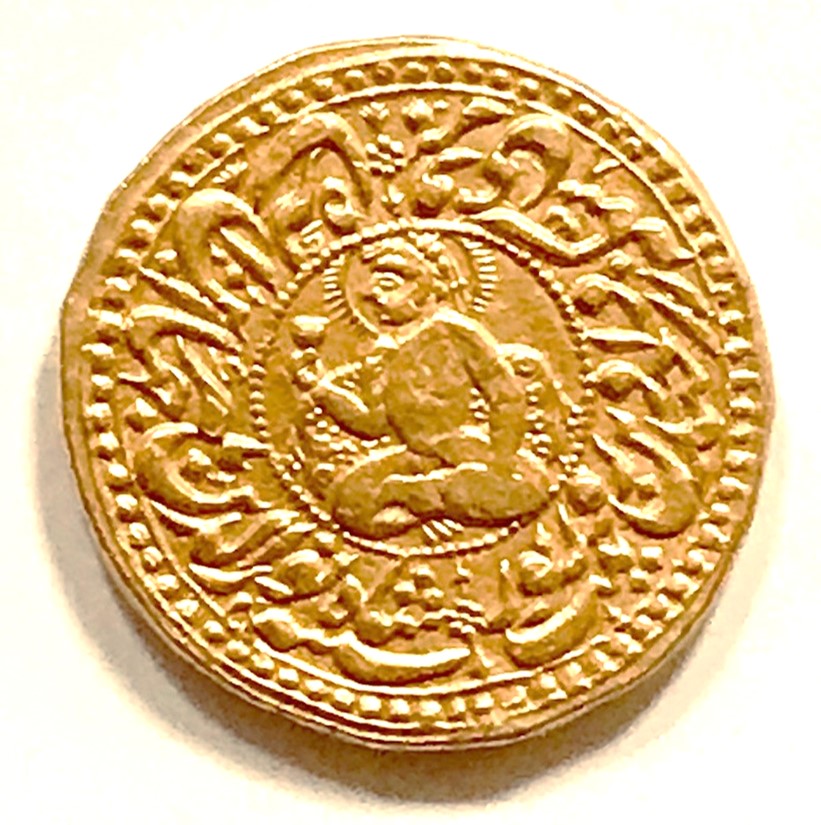
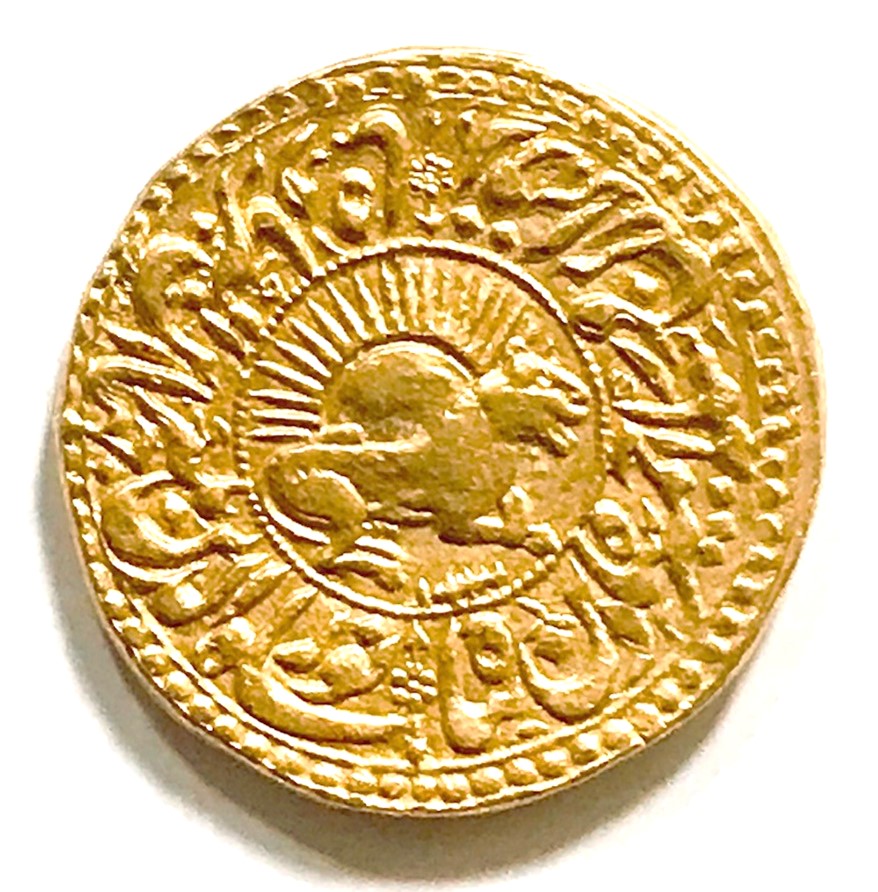
Jahangir
1605-1628 AD or 1014-1037 AH
Portrait Mohur, Weight: 11 gm, Gold
Obverse: Seated on throne or gaddi, a cross-legged figure of Jahangir with radiate head to left on Mughal throne, holding goblet in right hand, within inner dotted circle, legend around.
Reverese: In center lion to right surmounted by sun, the legend around. The distich or couplet on both the sides of coin is described below.
Minted at Ajmer in 1023 AH, Regnal year 8
Reference: BMC#318, plate IX (the same dies)R.B. Whitehead, numismatic chronicle 1929, type VII, pp 22-23, plate 1, no 8 KM#179.5Choice
Extremely Fine-Uncirculated. One of the finest specimen
Extremely Rare

Jahangir
1605-1627 AD
Gold Mohur
Obverse: Turbaned bust of Jahangir with radiate head, holding a wine goblet in right hand, within inner dotted circle, legend around
Reverse: A lion to right surmounted by sun, the legend and year below
Minted in 1020 AH, No name of mint.Regnal year 6
Weight: 11.88 gm
Extremely Rare
Both the Mughal emperors displayed tremendous imagination and minted breathtaking examples of numismatic art. One of the most remarkable of these are Zodiacal coins minted by Jahangir. In his memoire, Tuzuk-e-Jahangiri he wrote `At this time it entered in my mind that in place of month they should substitute a figure of the constellation which belong to the month. For instance, in the month of Farwardin the figure of a ram, and in Urdbihist the figure of a bull. Similarly, in each month that a coin was struck, the figure of a constellation was to be on one face as if the sun was emerging from it. This usage is my own and had never been practiced until now‘. Thus during 1028 AH to 1033 AH (Regnal years 13-18) Jahangir minted beautiful specimens of numismatic arts in silver and gold.
Although all 12 zodiac signs adorned on gold coins, only 5 silver zodics were minted. These coins are very special and are extremely popular in the world of numismatics. These coins became extremely popular during his reign itself and were widely exchanged for 20 times higher value than their face values! Thus, they were hoarded by all the sections of population.
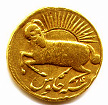
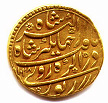
Jahangir
1605-1627 AD
Gold Mohur
Weight: 11.83 gm
Obverse: Ram charging to left (Aries), Sun in background, below it legend `sanat 14 jalus’
Reverse: Legend `Shah Akbar az Jahangir Shah yaft dar Agra ru ye 1028 zar ziwar’
Minted at Agra in 1028 AH, Regnal year 14, below Ram
Reference: KM#180.1, Friedberg #762; IMC#144, BM#322
Extremely Rare
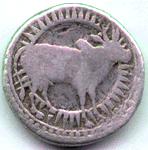
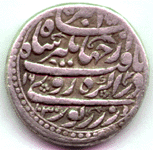
Jahangir
1605-1627 AD
Silver Rupee
Obverse: Bull (Taurus), Sun in background
Minted at Agra in 1621 AD (1030 AH)
Regnal year 16
Weight: 11.14 gm
Rare
A silver zodiac coin struck using gold dies
Silver Zodiac coins were minted initially from Ahmadabad in 1027 AH for five months, hence we see five genuine silver zodiacs, Aries, Taurus, Gemini, Cancer and Leo. This collection has the complete set of silver zodiacs. Their large scale minting was possibly stopped as Jahangir left the city of Ahmadabad for Agra. Once Jahangir reached Agra, the Zodiacs were issued from there. All the silver zodiacs minted from Agra are very rare and special; they were minted using dies for gold Zodiac Mohurs. Similarly, Kashmir, Fathpur, Lahore and Urdu (camp) mints also issue silver Zodiacs, which too are fairly rare (and have been minted at later dates). Majority of the silver zodiacs, having later dates are often minted using dies for Gold zodiacs. If one does not find the die similarity, one should treat them with caution. Gold Zodiacs were minted with all the 12 distinct signs. they all are extremely rare and highly sought after by collectors. Today, only 3 museums in world, the Bibliotheque Nationale de Paris, Berlin museum and British museum are known to have all the 12 gold zodiacal coins. The images of some of the zodiacal coins are shown above and below.

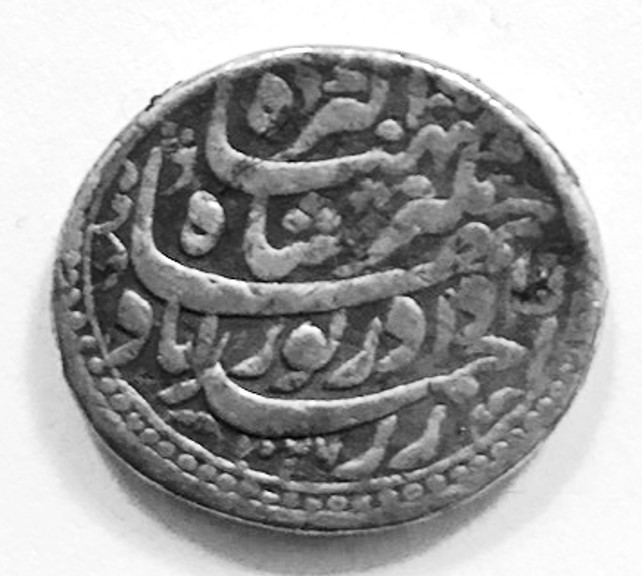
Jahangir
1605-1627 AD
Silver Rupee
Obverse: Crab(Cancer), Sun in background
Minted at Agra in 1618 AD (1027 AH), Regnal year 13
Weight: 11.14 gm
Rare
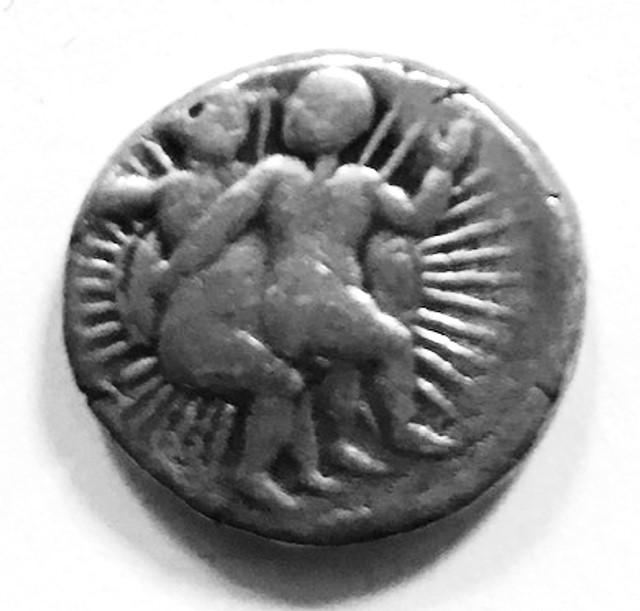
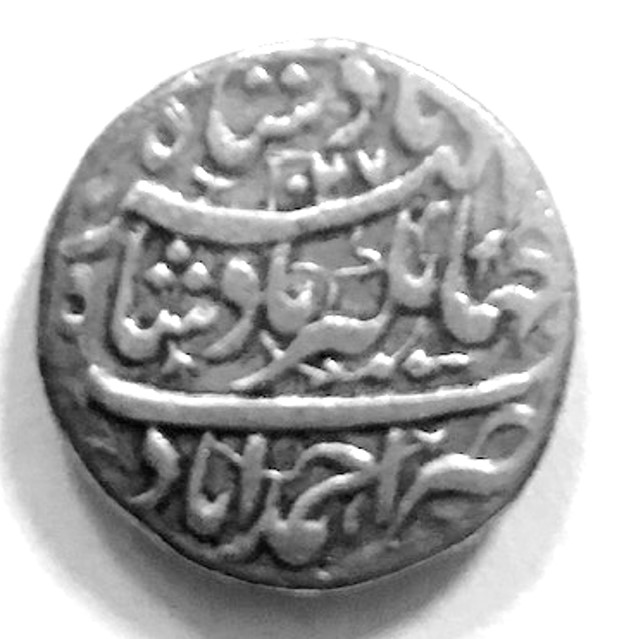
Jahangir
1605-1627 AD
Silver Rupee
Obverse: Gemini-the Twins (Mithuna), Sun in background
Minted at Ahmedabad in 1618 AD (1027 AH)
Regnal year 13
Weight: 11.14 gm
Rare
The silver zodiac coins were minted for only five months in 1618 AD or 1027 AH (regnal year 13) while gold zodiac mohurs were struck for full five years. Most of gold zodiacs were minted at Agra while most silver zodiacs (but not all) were primarily minted at Ahmadabad. Few silver coins were minted at Agra using dies for gold zodiac mohurs. Shown above is that very rare silver coin which was struck from dies which were used for making gold zodiac Mohurs.

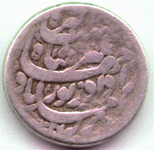
Jahangir
1605-1627 AD
Silver Rupee
Obverse: Lion (Leo) and sun in background
Minted at Ahmadabad in 1619 AD (1028 AH)
Weight: 11.14 gm
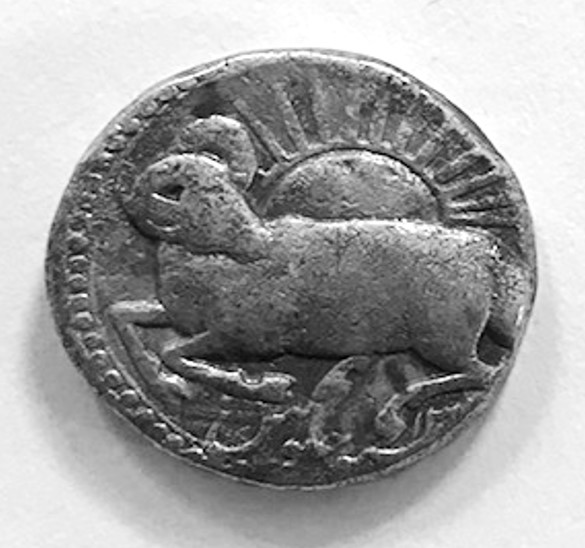

Jahangir
1605-1627 AD
Silver Rupee
Obverse: Ram (Aries) and sun in background
Minted at Ahmadabad in 1619 AD (1028 AH) Reganl year 14 (below Ram)
Weight: 11.14 gm
Because of their `un-Islamic’ nature, Jahangir’s successors, Shahjahan and Aurangzeb recalled these coins from circulation and melted them in Royal mints. But because of their tremendous popularity, they were hoarded. Some of the European travellers have mentioned these coins in their memoirs and may have acquired them and taken them to Europe, where they seem to have survived in various collection.
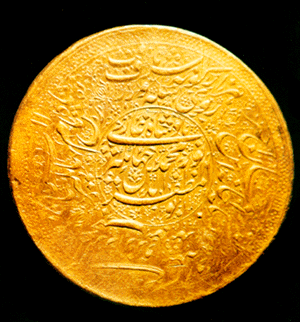
Some of the Jahangir’s coins were in gigantic in dimensions. It is mentioned in `Badshah Nama’ that on Jahangir’s birthday, the Persian Ambassador was presented with 4 Gold Ashrafis wighing 400 tolas (4.6 Kg), 300 tolas (3.5 Kg), 200 tolas (2.3 Kg) and 100 tolas (1.2 Kg)!
Shown on left is the image of `the 1000 tola coin’ (I do NOT have this coin), which is world’s biggest gold coin and thus likely to be the world’s most expensive coin. This coin has diameter of 20 cm and contains 383.75 troy ounces or almost 12 Kilograms (25 pounds) of pure gold!!!
Jahangir
1605-1627 AD
1000 Mohur
Weight: 12 Kgs (~25 pounds)Gold
Unique (provenance: unknown)
The gigantic Mughal coins are of special importance in Indian as well as world numismatics. One thousand tola gold mohur of 12 Kgs minted by Jahangir in 1613, shown above realistically display the wealth that was accumulated by this dynasty. Most of these gold muhars/mohurs had poetic couplets in Persian and were the finest samples of craftmanship and metallurgy.
Shown below is a scarce coin of Jahangir minted at Elichpur (Achalpur in Vidharbha or Berar region of modern Maharashtra state)
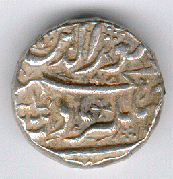
Jahangir
1605-1627 AD
Silver Rupee
Minted at Elichpur or Achalpur
Weight: 11.4 gm
Rare
SHAH JAHAN (1627-1658)
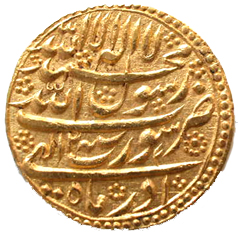
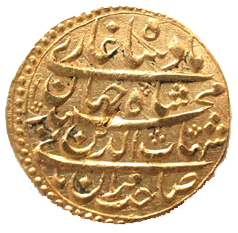
Shah Jahan
1627-1658 AD (1037-68 AH)
Gold Mohur
Minted at Surat
Weight: 11 gm
Scarce
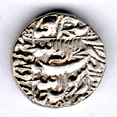
Shah Jahan
1627-1658 AD (1037-68 AH)
Silver Rupee
Minted at Bhakhar
Weight: 11.6 gm
Shahjahan took control of Mughal empire after death of Jahangir. Throughout his reign the empire was very prosperous and stable. This stability allowed him to take up many massive construction projects. One of the most important being the world famous `Taj Mahal’ built for his wife Mumtaz Begum. After her death, in memory he built this magnificent monument. The beauty and elegance of this monument is beyond description and millions visit every year to see it. Shahjahan built many other monuments during his reign. In his last days his son Aurangzeb took control of this dynasty (1658 AD). Shahjahan was imprisoned where he died 8 years later in 1666 AD.
Shown above are images of two his coins, both of which are in uncirculated condition and have the original shiny finish.
AURANGZEB (1658-1707)
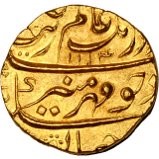
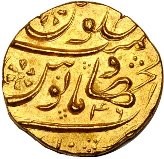
Aurangzeb
Mughal Dynasty, 1068-1118 AH or 1658-1707 AD
Mohur, Gold
Obverse: Minted in AH 1114, Yr46 at Dar al-Jihad Haiderabad
Reference: Fr-810, KM#315.20
Almost mint condition
Rare
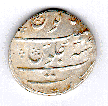
Aurangzeb Alamgir
1658-1707
Silver Rupee
Minted at Surat in 1682 (1092 AH)
Regnal Year 24
Weight: 11.6 gm
Aurangzeb was truly the last Mughal. He inherited a great empire after a lot of bloodshed. His elder brother Dara Shikoh was an intellectual and a liberal. He was quite popular, but was a poor general. Dara and his two brothers lost the battles. Dara and Murad Baksh were captured and executed, while their father ShahJahan was imprisoned. Aurangzeb throughout his long 49 years of reign tried to keep the empire intact. Unfortunately, unlike the Akbar and his son Jahangir, he was a fanatic ruler. His rule witnessed re-introduction of religious tax, Jizia, which he imposed on the majority Hindu population and was callous witness to their persecution. This created a tremendous displeasure and religious tension among many of his generals who were mostly Rajput and Maratha warriors. He lacked sympathy, imagination, breadth of vision and elasticity of choice of means. In spite of vitality and ceaseless campaigns again his enemies, Aurangzeb proved to be a failure as a ruler. In the intensity of his religious zeal, he ignored feelings of important sections of people (who did not profess Islam) and thus roused forces hostile to his empire.
In Deccan (South-Western India), Marathas, another warrior clan, united under able and wise king, Shivaji Bhonsale. Aurangzeb spent last 2 decades of his life fighting Marathas in Deccan (modern Maharashtra state). In spite of his all-out efforts to suppress Marathas, the spirit of religious freedom and independence was not lost in south. Locals had a last laugh; Aurangzeb died as a bitter old man realizing that his lack of piety and shallow interpretation of religion had destroyed the heritage of his forefathers and is buried in a village Khuldabad in Maharashtra. Soon after his death, his empire disintegrated and Marathas emerged as a supreme power in India.
Shown above are nice example of gold mohur (minted at Hyderabad) and the silver rupee, minted at Surat, during Aurangzeb’s reign.
FARRUKHSIYAR (1713-1719)
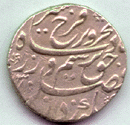
Farrukhsiyar 1713-1719 ADSilver RupeeMinted at Shahjahanabad (Delhi)Regnal year 8Weight: 10.76 gm
After death of Aurangzeb, war broke out between his sons for throne, the first sign of collapse of Mughal empire. Aurangzeb was followed by his eldest son Muazzam under title of Shah Alam I, after killing two of his younger brothers. He soon died in 1712 and thus war of succession started among his 4 sons. His eldest son Jahander shah emerged as a victorious. He killed his three other brothers and became emperor. Jahander Shah was completely under influence of his favorite lady, Lal Kumari. His brief reign was full of violence but mistrels, singers, dancers and actors had great time. He was hopeless ruler and finally deposed by his nephew Farrukhsiyar in 1713. Jahander Shah was strangled to death and his chief minister was also executed. Farrukhsiyar was elevated to throne by two Sayyid brothers who were governors of Patana and Allahabad. Farrukhsiyar was feeble and coward. He acted ungratefully towards Sayyid brothers. They resented this and eventually they deposed him, blinded him and had him executed.
MUHAMMAD SHAH (1719-1748)
